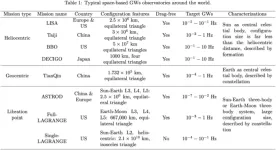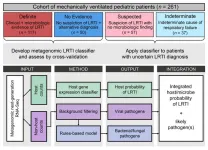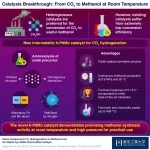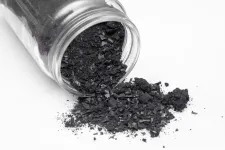(Press-News.org) By observing the night sky, medieval monks unwittingly recorded some of history’s largest volcanic eruptions. An international team of researchers, led by the University of Geneva (UNIGE), drew on readings of 12th and 13th century European and Middle Eastern chronicles, along with ice core and tree ring data, to accurately date some of the biggest volcanic eruptions the world has ever seen. Their results, reported in the journal Nature, uncover new information about one of the most volcanically active periods in Earth’s history, which some think helped to trigger the Little Ice Age, a long interval of cooling that saw the advance of European glaciers.
It took the researchers almost five years to examine hundreds of annals and chronicles from across Europe and the Middle East, in search of references to total lunar eclipses and their colouration. Total lunar eclipses occur when the moon passes into the Earth’s shadow. Typically, the moon remains visible as a reddish orb because it is still bathed in sunlight bent round the Earth by its atmosphere. But after a very large volcanic eruption, there can be so much dust in the stratosphere – the middle part of the atmosphere starting roughly where commercial aircraft fly – that the eclipsed moon almost disappears.
Medieval chroniclers recorded and described all kinds of historical events, including the deeds of kings and popes, important battles, and natural disasters and famines. Just as noteworthy were the celestial phenomena that might foretell such calamities. Mindful of the Book of Revelation, a vision of the end times that speaks of a blood-red moon, the monks were especially careful to take note of the moon’s coloration. Of the 64 total lunar eclipses that occurred in Europe between 1100 and 1300, the chroniclers had faithfully documented 51. In five of these cases, they also reported that the moon was exceptionally dark.
The contribution of Japanese scribes
Asked what made him connect the monks’ records of the brightness and colour of the eclipsed moon with volcanic gloom, the lead author of the work, Sébastien Guillet, senior research associate at the Institute for environmental sciences at the UNIGE, said: “I was listening to Pink Floyd’s Dark Side of the Moon album when I realised that the darkest lunar eclipses all occurred within a year or so of major volcanic eruptions. Since we know the exact days of the eclipses, it opened the possibility of using the sightings to narrow down when the eruptions must have happened.”
The researchers found that scribes in Japan took equal note of lunar eclipses. One of the best known, Fujiwara no Teika, wrote of an unprecedented dark eclipse observed on 2 December 1229: ‘the old folk had never seen it like this time, with the location of the disk of the Moon not visible, just as if it had disappeared during the eclipse... It was truly something to fear.’ The stratospheric dust from large volcanic eruptions was not only responsible for the vanishing moon. It also cooled summer temperatures by limiting the sunlight reaching the Earth’s surface. This in turn could bring ruin to agricultural crops.
Cross-checking text and data
“We know from previous work that strong tropical eruptions can induce global cooling on the order of roughly 1°C over a few years,” said Markus Stoffel, full professor at the Institute for environmental sciences at the UNIGE and last author of the study, a specialist in converting measurements of tree rings into climate data, who co-designed the study. “They can also lead to rainfall anomalies with droughts in one place and floods in another.”
Despite these effects, people at the time could not have imagined that the poor harvests or the unusual lunar eclipses had anything to do with volcanoes – the eruptions themselves were all but one undocumented. “We only knew about these eruptions because they left traces in the ice of Antarctica and Greenland,” said co-author Clive Oppenheimer, professor at the Department of Geography at the University of Cambridge. “By putting together the information from ice cores and the descriptions from medieval texts we can now make better estimates of when and where some of the biggest eruptions of this period occurred.”
Climate and society affected
To make the most of this integration, Sébastien Guillet worked with climate modellers to compute the most likely timing of the eruptions. “Knowing the season when the volcanoes erupted is essential, as it influences the spread of the volcanic dust and the cooling and other climate anomalies associated with these eruptions,” he said.
As well as helping to narrow down the timing and intensity of these events, what makes the findings significant is that the interval from 1100 to 1300 is known from ice core evidence to be one of the most volcanically active periods in history. Of the 15 eruptions considered in the new study, one in the mid-13th century rivals the famous 1815 eruption of Tambora that brought on ‘the year without a summer’ of 1816. The collective effect of the medieval eruptions on Earth’s climate may have led to the Little Ice Age, when winter ice fairs were held on the frozen rivers of Europe. “Improving our knowledge of these otherwise mysterious eruptions, is crucial to understanding whether and how past volcanism affected not only climate but also society during the Middle Ages,” concludes the researcher.
END
The unexpected contribution of medieval monks to volcanology
By analyzing medieval texts, an international team led by the UNIGE has succeeded in precisely dating some of the largest eruptions in history
2023-04-05
ELSE PRESS RELEASES FROM THIS DATE:
Is artificial intelligence better at assessing heart health?
2023-04-05
Who can assess and diagnose cardiac function best after reading an echocardiogram: artificial intelligence (AI) or a sonographer?
According to Cedars-Sinai investigators and their research published today in the peer-reviewed journal Nature, AI proved superior in assessing and diagnosing cardiac function when compared with echocardiogram assessments made by sonographers.
The findings are based on a first-of-its-kind, blinded, randomized clinical trial of AI in cardiology led by investigators in the Smidt Heart Institute and the Division of Artificial Intelligence in Medicine at Cedars-Sinai.
“The results have immediate implications for ...
Gwangju Institute of Science and Technology researchers correlate Arctic warming to extreme winter weather in midlatitude and its future
2023-04-05
Pictures of melting glaciers and stranded polar bears on shrinking sea ice in the Arctic are perhaps the most striking images that have been used to highlights the effects of global warming. However, they do not convey the full extent of the consequences of warmer Arctic. In recent years, there has been growing recognition of the Arctic’s role in driving extreme weather events in other parts of the world. While the Arctic has been warming at a rate twice as fast as the global average, winters in the midlatitude regions have experienced colder and more severe weather events. For instance, the winter of 2022-2023 saw record-breaking cold temperatures and snowfall ...
Finding a way to combat long COVID
2023-04-05
A new study has identified potential neurological biomarkers of long COVID-19 in nonhuman primates that may help physicians diagnose, monitor and treat this condition.
Over 65 million people worldwide have developed long COVID after being infected with SARS-CoV-2, and cases are only becoming more common. Long COVID symptoms can last weeks, months or years. Even more perplexing is the fact that symptoms can vary widely between individuals and consist of any combination of fatigue, fever, chest pain, trouble breathing, neurological symptoms such as ...
Overview of orbital mechanics for space-based gravitational wave observatories
2023-04-05
Gravitational waves (GWs) are “ripples in space-time”. The detection of gravitational waves (GWs) is critical to the understanding of the origin and evolution of stars, galaxies, and the Universe. At present, the laser interferometry is the most commonly use technology to detect GWs by measuring the phase change between two beams of coherent light. Due to the limitations of arm length, the ground-based GWs measurement is hard to detect the low-frequency GWs. While the space-based GWs observation is capable of longer arm length of the interferometer, the detection of GWs in space is expected to cover a greater number and variety of ...
Cracking the puzzle of lower respiratory tract infections in children
2023-04-05
Lower respiratory tract infection (LRTI), which includes conditions such as pneumonia, has long been the leading cause of death from communicable agents and a leading cause of death in children worldwide. But despite its prevalence, LRTI is tricky for doctors to treat effectively because the current diagnostic approach often fails to conclusively determine whether an infection is present at all, and if so, what pathogen is causing it.
Now, in a study published April 3, 2023 in The Journal of Clinical Investigation, a team led by researchers at the Chan Zuckerberg Biohub San Francisco (CZ Biohub SF), UC San Francisco (UCSF), the University ...
Opening a new frontier: PdMo intermetallic catalyst for promoting CO2 utilization
2023-04-05
Being the most abundant and persistent greenhouse gas emitted, carbon dioxide (CO2) is the key driver of climate change. To address the pressing problems associated with climate change and fossil fuel depletion, scientists are looking for viable solutions that can minimize the amount of CO2 released into the atmosphere. One attractive solution to this problem is to convert atmospheric CO2 into more useful compounds. Towards this end, methanol - a raw material, fuel additive, and energy carrier, is widely being explored as a promising conversion option for CO2.
Now, while various catalysts ...
SwRI, Tec de Monterrey award funding for sustainable manufacturing research
2023-04-05
SAN ANTONIO — April 5, 2023 —Southwest Research Institute and Tecnológico de Monterrey (Tec de Monterrey) will jointly fund three research and development initiatives to advance sustainable manufacturing and technology in the United States and Mexico. The trio of projects are the first selected to receive support through the Sustainable Manufacturing Program, a transnational research and development collaboration established between SwRI and Tec de Monterrey — a private, nonprofit, independent university based in Monterrey, Mexico — in August 2022. The program provides grant opportunities funded ...
How were amino acids, one of the key building blocks of life, formed before the origin of life on Earth? Tiny particles from the near Earth asteroid Ryugu can help answer this profound question
2023-04-05
Our solar system formed from a molecular cloud, which was composed of gas and dust that was emitted into the interstellar medium (ISM), a vast space between stars. On collapse of the molecular cloud, the early sun was formed, with a large disk of gas and dust orbiting it. The dusty material collided to produce rocky material that would eventually grow in size to give large bodies called planetesimals.
The planetesimals that formed far enough from the sun, also contained large quantities of ice. The ice consisted of water and other volatile compounds, such as carbon monoxide (CO), carbon dioxide (CO2), methanol (CH3OH) and ammonia (NH3), as well as ...
Air pollution is linked to lower COVID-19 vaccine responses
2023-04-05
People exposed to higher levels of air pollution before the pandemic had lower antibody responses to COVID-19 vaccines, according to a study led by the Barcelona Institute for Global Health (ISGlobal), an institution supported by “la Caixa” Foundation, in collaboration with the Germans Trias i Pujol Research Institute (IGTP). In particular, exposure to fine particulate matter (PM2.5), nitrogen dioxide (NO2) and blank carbon (BC) was associated with about a 10% decrease in IgM and IgG antibody responses in people without prior infection. The findings, published in Environmental Health Perspectives, ...
More than a third of children worry at least once a week, with their tendency to worry progressing with age, according to national survey by Nemours KidsHealth(R)
2023-04-05
WILMINGTON, Del. (April 5, 2023) – More than one in three children ages 9 to 13 (37%) worry at least once a week, primarily about school (64%) and friendships (41%), with their tendency to worry progressing with age. Older children (age 13) are more likely than their younger counterparts to report feeling as though they will never stop worrying (48% vs. 22% for 9-year-olds). This is according to the results of What’s Worrying America’s Kids, a national survey conducted by The Harris Poll on behalf of Nemours KidsHealth. The survey results ...
LAST 30 PRESS RELEASES:
The perfect plastic? Plant-based, fully saltwater degradable, zero microplastics
Bias in data may be blocking AI’s potential to combat antibiotic resistance
Article-level metrics would provide more recognition to most researchers than journal-level metrics
Satiety’s little helper: Protein that supports appetite regulating protein identified
UF dives deep into predicting storm damage with computer models
A stormy ocean voyage yields insights on the global carbon cycle
Scientists identify first non-coding gene that controls cell size
Demonstration of altermagnetism in RuO₂ thin films -- A new magnetic material for the AI era
Penn researchers awarded $25M to conduct trial using smartphones to fight heart disease
PCORI awards funding for new patient-centered healthcare research
Exploring the origins of the universe: 145 low-noise amplifiers complete ALMA telescopes
Empress cicada wings help illuminate molecular structure
Using sound waves to detect helium
Time burden in patients with metastatic breast and ovarian cancer from clinic and home demands
Researchers discover bias in AI models that analyze pathology samples
Scientists ID potential way to prevent brain injuries from triggering Alzheimer's
MASTER 2nd Open Call: Execution period kick-off
Algae for health in food and pharma
Advanced microrobots driven by acoustic and magnetic fields for biomedical applications
Chicago health information leader recognized for raising CPR readiness and blood pressure awareness
The Intimate Animal, a new book from Kinsey Institute Executive Director Dr. Justin Garcia
When blue-collar workers lose union protection, they try self-employment
New video dataset to advance AI for health care
MEA-based graph deviation network for early autism syndrome signatures in human forebrain organoids
New modeling approach sheds light on rare gut disease
Study documents potentially hazardous flame retardants in firefighter gear
Can certain bacteria regulate aging of the immune system and its related alterations?
AI model helps diagnose often undetected heart disease from simple EKG
There are fewer online trolls than people think
Cell membrane fluctuations produce electricity
[Press-News.org] The unexpected contribution of medieval monks to volcanologyBy analyzing medieval texts, an international team led by the UNIGE has succeeded in precisely dating some of the largest eruptions in history





